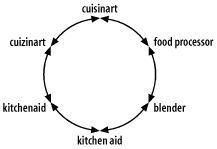Controlled Vocabularies
Vocabulary control comes in many shapes and sizes. At its most vague, a controlled vocabulary is any defined subset of natural language. At its simplest, a controlled vocabulary is a list of equivalent terms in the form of a synonym ring, or a list of preferred terms in the form of an authority file. Define hierarchical relationships between terms (e.g., broader, narrower) and you’ve got a classification scheme. Model associative relationships between concepts (e.g., see also, see related) and you’re working on a thesaurus. Figure 9-1 illustrates the relationships between different types of controlled vocabularies.

Figure 9-1. Types of controlled vocabularies
Since a full-blown thesaurus integrates all the relationships and capabilities of the simpler forms, let’s explore each of these building blocks before taking a close look at the “Swiss Army Knife” of controlled vocabularies.
Synonym Rings
A synonym ring (see Figure 9-2) connects a set of words that are defined as equivalent for the purposes of retrieval. In practice, these words are often not true synonyms. For example, imagine you’re redesigning a consumer portal that provides ratings information about household products from several companies.

Figure 9-2. A synonym ring
When you examine the search logs ...
Get Information Architecture for the World Wide Web, Second Edition now with the O’Reilly learning platform.
O’Reilly members experience books, live events, courses curated by job role, and more from O’Reilly and nearly 200 top publishers.

